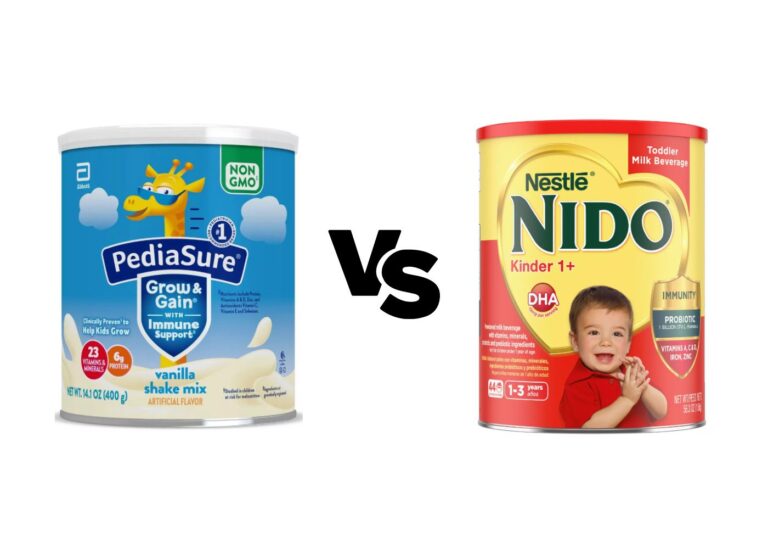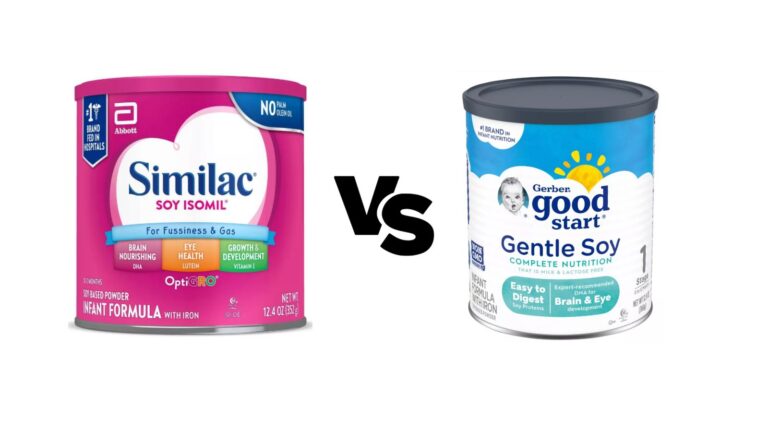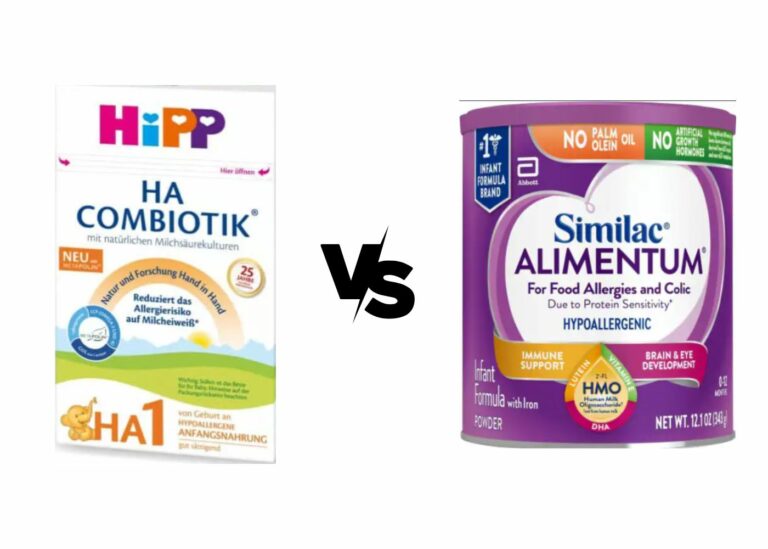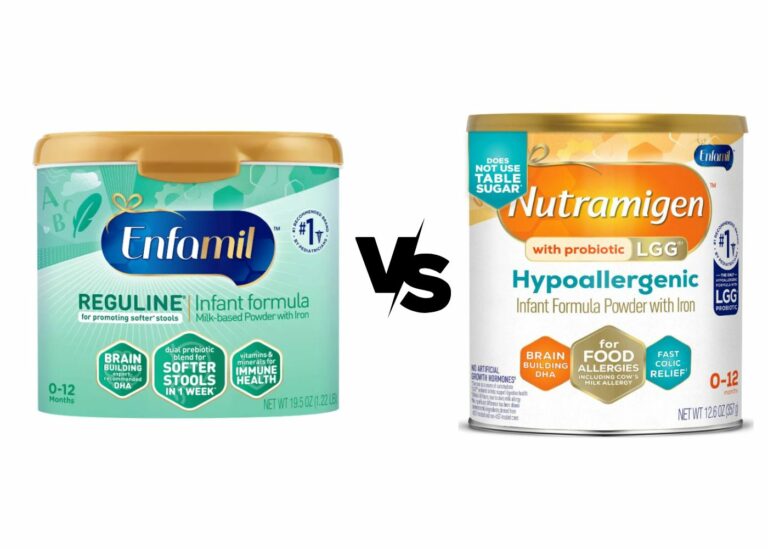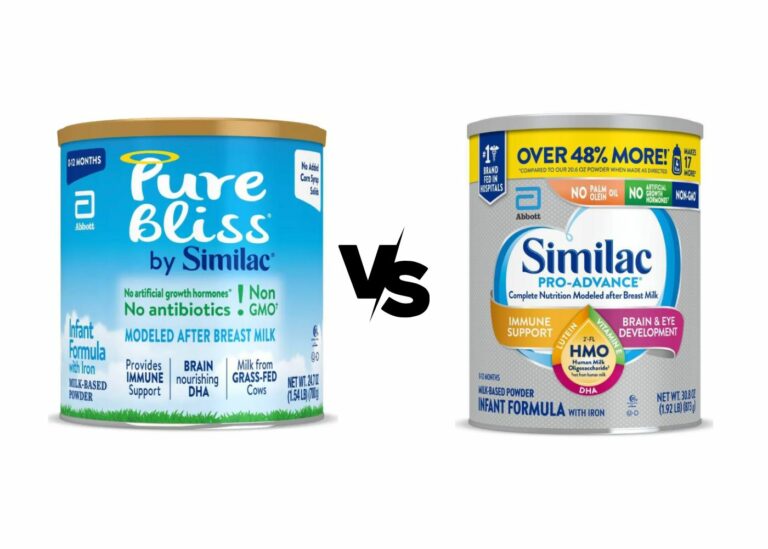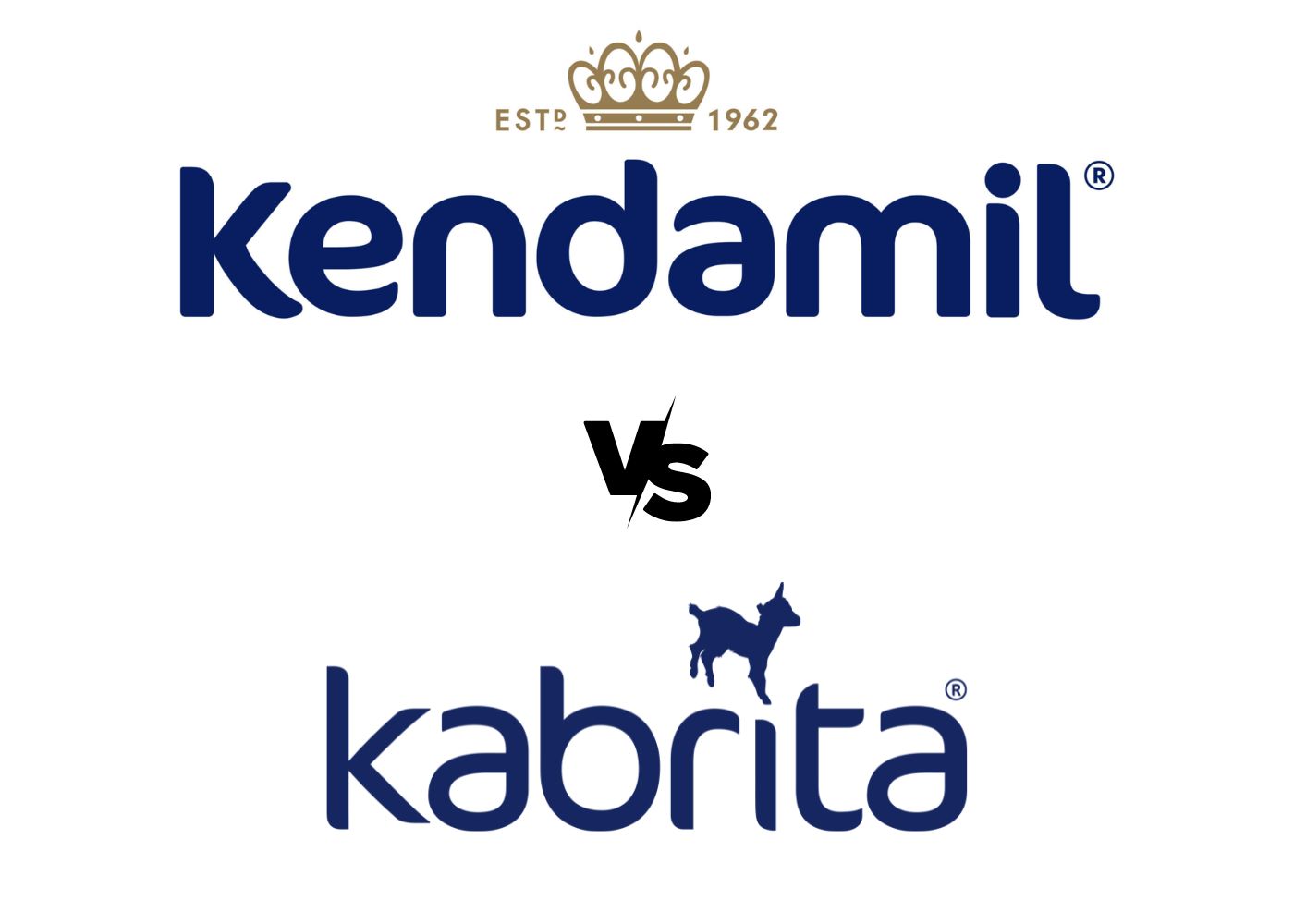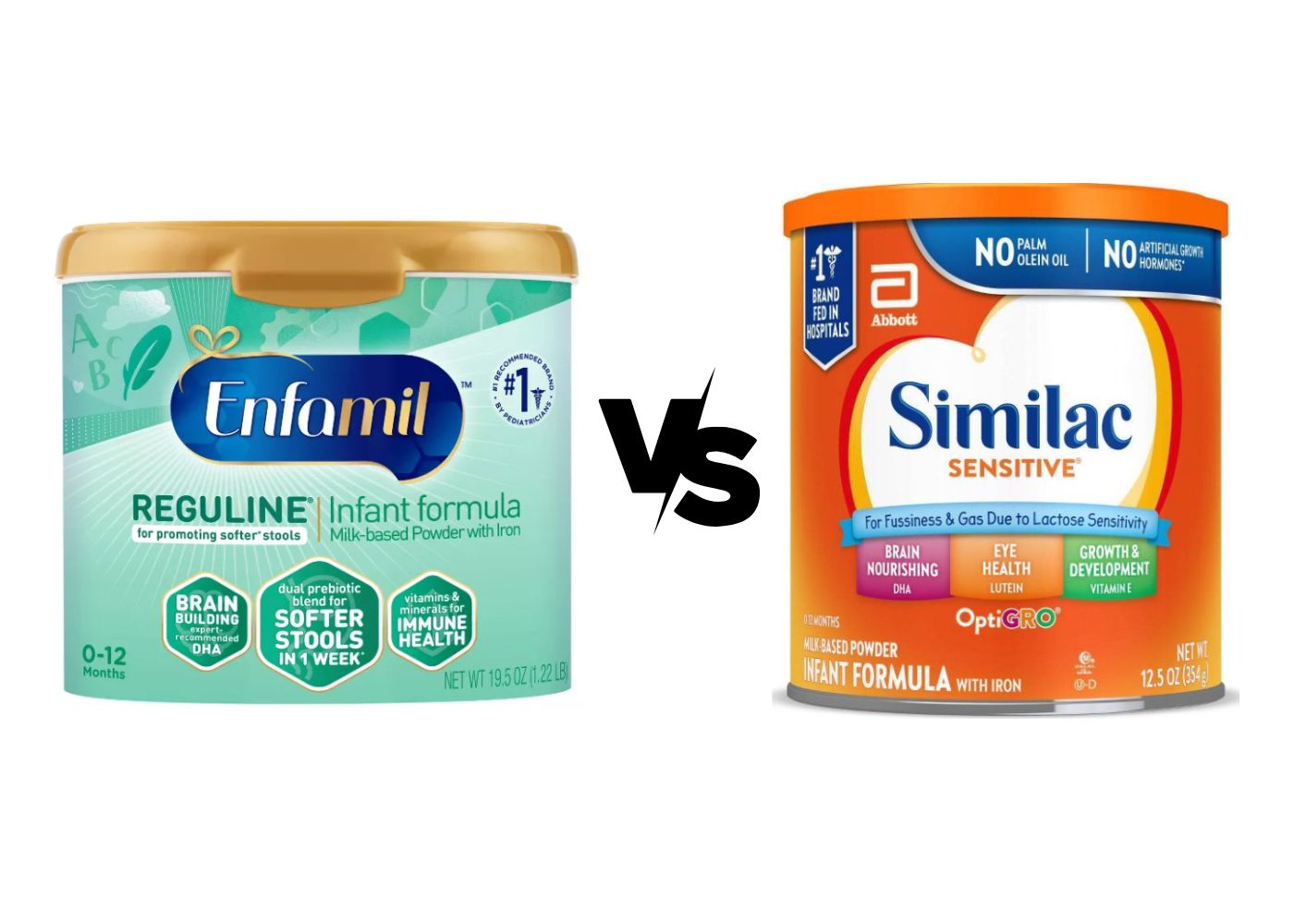
Key Differences Between Enfamil Reguline and Similac Sensitive
| Aspects | Enfamil Reguline | Similac Sensitive |
|---|---|---|
| Brand Reputation | (Favored for addressing constipation, Potential Allergenic Ingredients – soy, milk, coconut, Hydrolyzed Protein for easier digestion, Dual Prebiotics) | (Catering to babies with sensitive tummies, No Palm Olein, No artificial growth hormones, Suitable for lactose intolerant babies) |
| Protein Source & Content | Partially hydrolyzed nonfat milk & Whey protein concentrate solids (2.3g per serve) | Milk protein isolate (2.1g per serve) |
| Carbohydrate Source & Content | Lactose & Corn syrup solids (11.1g per serve) | Corn syrup & Sugar (10.9g per serve, Lactose-free) |
| Fat Source & Content | Palm Olein, Coconut, Soy, High Oleic Sunflower Oils, Mortierella Alpina & Crypthecodinium Cohnii Oils (5.3g per serve) | High Oleic Safflower/Sunflower Oil, Soy Oil, Coconut Oil, Crypthecodinium Cohnii & Mortierella Alpina Oils (5.4g per serve, No Palm Olein) |
| Probiotics & Prebiotics | (Dual Probiotics, GOS and Polydextrose Prebiotics) | ❌ (No Probiotics, Short-Chain Fructooligosaccharides Prebiotic) |
| Availability | (Target), (Walmart) | (Target), (Walmart) |
Blwstore is supported by its audience. When you buy through links on our site, we may earn an affiliate commission.
This article aims to compare two popular sensitive formulas in the US: Enfamil Reguline vs Similac Sensitive.
We will analyze their ingredients and nutritional composition to give you the information you need to make an informed decision.
Let’s get after it!
*Related read: Enfamil Reguline vs Similac Total Comfort
Our Short Answer
After analyzing in detail the ingredients and nutritional information of both formulas, these are our conclusions:
Enfamil Reguline is a more complete and healthier formula in almost every way, and should be your choice in most cases:
– Partially hydrolyzed protein for easier digestion (Learn more: Hydrolyzed Formulas)
– Reduced lactose content
– Two prebiotics (GOS and Polydextrose)The only aspect in which Similac Sensitive is superior is the fact that it does not use palm olein.
Similac Sensitive should only be considered if your baby suffers from severe lactose intolerance. This is the only case in which this formula is worth considering.
As always, we recommend you read about the alternatives we recommend below in the article.
What About Reguline vs Similac Pro-Sensitive?
If you are considering Similac Pro-Sensitive instead of Sensitive, the only difference is that “Pro-Sensitive” adds 2′-FL HMO, a prebiotic found in breast milk that is quite beneficial to babies.
*Read: Similac Sensitive vs Pro-Sensitive
Even with this addition, Enfamil Reguline would still be our choice for using hydrolyzed protein, but it depends on your baby’s needs.
At BLWStore, we may earn a commission from some of the products featured on our website through affiliate partnerships with retailers. We want to be transparent with our readers and let you know that we do not receive any products for special consideration. The commission we earn helps support our website and allows us to continue providing helpful information and product recommendations. Thank you for your support!
Overview of the two formulas
Enfamil Reguline addresses occasional constipation with easy-to-digest proteins and a prebiotic blend for soft stools. It includes a dual probiotic blend, expert-recommended DHA for brain development, and immune support.
Similac Sensitive caters to sensitive tummies, addressing fussiness and gas due to lactose sensitivity. It contains DHA and lutein for brain development and is free from palm olein oil and artificial growth hormones.
Both formulas provide complete nutrition for infants up to 12 months.
Enfamil Reguline
Enfamil Reguline is a baby formula that has been trusted by pediatricians and parents alike. Enfamil markets this product as an effective solution to occasional constipation in infants. The formula contains easy-to-digest proteins and a prebiotic blend that promotes soft, comfortable stools within its first week of use.
Aside from addressing constipation problems, the formula has a dual probiotic blend and contains an expert-recommended level of DHA (a type of Omega-3 fat) for brain development. It also supports immune system functioning with its prebiotics content and various vitamins.
This Enfamil product is gentle enough for everyday use and provides complete nutrition throughout your baby’s first 12 months. However, it’s important to note that soy, milk, and coconut could be allergenic for some babies.
Similac Sensitive
Aiming to cater to babies with sensitive tummies, Similac Sensitive is an easy-to-digest infant formula designed specifically for fussiness, gas, or mild spit-up due to lactose sensitivity.
Similarly beneficial for brain development, this product includes DHA and lutein, essential nutrients found in breast milk. Besides these benefits, this product boasts no palm olein oil inclusion- a factor contributing to better calcium absorption.
Recognized as the #1 infant formula brand served in hospitals, Similac ensures no artificial growth hormones in their products; hence it’s healthier and safer for your little one.
This formula is suitable if your child has lactose sensitivity or if he/she experiences fussiness or gas due to digestive issues.
Nutritional Composition
Reguline uses partially hydrolyzed nonfat milk and whey protein concentrate, while Sensitive uses milk protein isolate. Reguline’s partially hydrolyzed protein makes it easier to digest.
Reguline contains 11.1g of carbohydrates, mainly from lactose and corn syrup solids, while Sensitive has 10.9g of carbohydrates from corn syrup and sugar.
Reguline’s lactose content is advantageous for most babies. In fat content, Sensitive has a slight edge as it avoids palm olein oil.
Protein Content
In every 5 fl oz serving, Enfamil Reguline provides 2.3g of protein, while Similac Sensitive offers slightly less with 2.1g.
Enfamil Reguline’s protein source is partially hydrolyzed nonfat milk and whey protein concentrate solids (soy). This protein is easier to digest, making it ideal for babies with digestive problems.
Similac Sensitive formula uses milk protein isolate which is also known for its easy digestibility in babies with sensitive tummies. It can reduce fussiness and gas due to lactose sensitivity.
The fact that Reguline uses partially hydrolyzed milk gives it the easy win here. Partially hydrolyzed protein is partially broken down, which means that it’s pre-digested, making it easier for babies to process.
Similac Sensitive has milk protein isolate, meaning it isolates the protein from other milk components, ensuring there are no lactose traces. However, this does not mean that it is an easier to digest protein.
Carbohydrate Content
Enfamil Reguline contains roughly 11.1g of carbohydrates per 5 fl oz serving derived mainly from lactose and corn syrup solids. The lactose content mimics breast milk, which makes it advantageous for babies’ diets.
Similac Sensitive has slightly less carbs, at 10.9g per 5 fl oz serving, sourced from corn syrup and sugar. The absence of lactose in their carbohydrate source – an essential sugar in breast milk- makes Similac Sensitive suitable for lactose intolerant or sensitive babies.
For babies without high lactose intolerance, Reguline is the way to go because it uses some lactose and corn syrup solids.
Similac does not use lactose and only adds corn syrup solids and sugars, which is far from ideal, but it would be a better option if your baby suffers from lactose intolerance.
Fats and Oils
Enfamil Reguline contains 5.3g of fat per 5 fl oz serving, mainly derived from vegetable oil (palm olein, coconut, soy, high oleic sunflower oils), mortierella alpina oil, and crypthecodinium cohnii oil. The last two mentioned oils provide a source of DHA & ARA – essential fatty acids found in breast milk that significantly support eyesight and brain development.
Similac Sensitive provides around 5.4g of fat per 5 fl oz serving with high oleic safflower oil, soy oil, coconut oil as primary fats sources along with C.cohnii oil (source of DHA) & M.alpina oil (source of ARA). It’s worth noting that this formula does not contain palm olein oil which allows better calcium absorption and is beneficial in building strong bones for the child.
The only difference in fat content is that Enfamil uses palm olein, a more processed version of palm oil. This ingredient is controversial and has its pros and cons. Learn more here.
That is why we give the win to Similac Sensitive in fat content.
Probiotics and Prebiotics
Enfamil Reguline has a dual probiotic blend and prebiotics (GOS and Polydextrose) for a healthy gut and strengthened immunity.
Similac Sensitive contains prebiotics (short-chain fructooligosaccharides) but does not mention probiotics.
Probiotics and prebiotics are important in a baby formula as they contribute to a healthy gut, which is key to your baby’s overall health.
Enfamil Reguline contains a dual probiotic blend for softer stools and easier digestion. In addition, it has prebiotics (GOS and Polydextrose) which encourages the growth of beneficial bacteria in the gut and hence, strengthens the immune system.
Similac Sensitive formula primarily contains prebiotics known as short-chain fructooligosaccharides, which also feeds the good bacteria in your baby’s intestine, promoting a healthy digestive system. However, it does not provide any statement about containing probiotics.
Best Places to Buy Enfamil Reguline and Similac Sensitive


Enfamil Reguline
Similac Sensitive
Buy Similac Sensitive at Target
Buy Similac Sensitive at Walmart
What are the best alternatives to Enfamil Reguline and Similac Sensitive?
Hipp HA: It’s one of the top-rated hypoallergenic formulas. If your child shows signs of formula intolerance or is at risk of developing allergies, this could be your best bet, as its proteins are designed to be easier to digest. *Read: Hipp HA vs Enfamil Gentlease
Hipp Comfort and Hipp Anti-Reflux: Both formulas are manufactured for babies with lactose sensitivity or those experiencing digestive discomforts. They contain reduced lactose content and other dietary fibers, which makes them gentle on the baby’s tummy. *Read: Hipp Comfort vs Hipp Anti-Reflux
High-quality goat milk formulas like Kendamil Goat or Nannycare: Goat’s milk protein is slightly different from cow’s milk protein, making it easier for some babies to digest. So, if your baby has problems digesting cow’s milk protein but does not have a diagnosed Cow Milk Protein Allergy (CMPA), these brands might be worth considering. *Read: Kendamil vs Nannycare
Last Words
We hope this comparison between Enfamil Reguline and Similac Sensitive helps you make an informed decision.
We strongly encourage you to read about our recommended alternatives above before making any purchasing decisions.
Happy feeding!
We’re Maria and Alberto, a married couple and educators who are nutrition enthusiasts. Even before we had kids, we were already crazy about nutrition.
We’d read scientific articles, watch videos from nutritionists, and spend hours listening to nutrition podcasts.
Today, we continue doing this, but in a different way, as we’ve learned to sift through the noise and trends. Nutrition, like any other field of knowledge, the more you read and learn, the more you develop a comprehensive understanding of reality, and that’s what has happened to us.
Before having our first child, we focused on learning everything we could about child nutrition, using the same techniques we had already employed, backed by our extensive knowledge in nutrition.
Our mission is to help other parents with their children’s nutrition, to help them become the best versions of themselves.
If we are what we eat and drink, which is absolutely true, let’s do it right!


